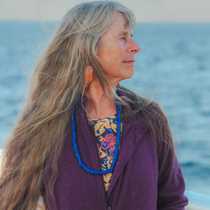Pavlof Harbor & Cruising for Marine Mammals
Early this sunny morning, the National Geographic Sea Lion cruised into a small body of water on the northeastern side of Chichagof Island. As the engines slowed, our ship positioned into a safe site for our morning anchorage. We were scheduled to do some hiking, kayaking and Zodiac cruises in and around Pavlof Harbor.
This bay is well-known for a salmon stream that has been used by human populations to harvest this abundant fish for thousands of years. A beach on one side of the bay had been an ancient summer village site for indigenous peoples. Later settlers used the same site for a cannery, again harvesting the bountiful supply of salmon returning to their natal stream.
Once ashore, hikers headed into the forest to explore the unique wooded terrain near the stream. The sound of rushing water mixed with bird songs filled the forest. Following in the footprints of Brown bears, literally, we dipped under the bows of Hemlock and Sitka spruce trees into the cooler temperatures and shade of a thick and extremely healthy northern temperate forest. Our trail led us along the river and waterfall, and up one side of the falls to a quiet lake. We made our way past a beaver lodge, continuing on the bear paths, and found ourselves in a thick grassy meadow scented by bog orchids and laced in morning dew. Taking a moment before returning from our forest explorations, we took in the backdrop of mountains behind the lake adding to the gift of a visual feast that encompassed the small and large components that make up this unique ecosystem.
Meanwhile kayakers headed out to explore Pavlof Harbor and several nearby smaller bays. Traveling at an extreme low tide from the previous night’s full moon many a kayaker found the sea offering up just as many gifts as the land. Star fish, jelly fish and extremely clear water found kayakers gazing down into thirty feet of water at schools of salmon staging…..waiting…..for exactly the perfectly timed moment to reenter their natal streams, in hopes of starting the next generation of salmon.
All too soon the morning passed, though many of us were just a tad over heated from extremely high air temperatures. An offer went out for a chance to swim in the clean and very refreshing waters of Southeast Alaska. Sixteen hearty souls went by Zodiac a hundred yards away from the National Geographic Sea Lion and jumped, dove, flipped, and slid into the refreshing waters of Pavlof Harbor. The yells could be heard back aboard, not to mention the laughter and joy of taking a northern plunge just to say we did!
Our afternoon would be totally dedicated to whale watching. After another satisfying lunch we adjourned to various locations on board, keeping a serious lookout for the elusive cetaceans of Southeast Alaska. Rewarded almost immediately, we spotted killer whales in Iyoukeen Bay. We spent a short time moving in towards shore and watching four animals surfacing, taking a breath and diving again and again.
Moving off and continuing our passage north, a Brown bear was spotted on a beach near the home shore of Chichagof Island. We spent some time watching this bear lumbering down the beach occasionally glancing in our direction.
Early evening brought a change in our day’s light. As is common along the Northwest coast, weather changes often occur around a full moon. A thin layer of mist began to cloud our clear sky, turning the sun red orange and decorating the ripples of the water with those same colors.
We continued to cruise north heading for a well known feeding area for Humpback whales. Just after dinner, the final gift of the day brought everyone on board several hours watching Humpbacks feed at Point Adolphus. A group of at least twelve animals had been seen from a distance and as we approached slowly we could see a tremendous amount of activity. We watched rapid movements of surfacing, deep breathing and diving, all over and over. Obviously these animals were beginning their summer of intense feeding.
The National Geographic Sea Lion circled slowly as we, on foot, circled the National Geographic Sea Lion’s 200-level deck, watching Humpback whales moving all around us in a series of large circles. As light began to fade, two Humpbacks breached in what many said was the most symmetric double breach, followed by symmetric splashes. It was a signal; there was a deep sigh on the bow, followed by a slow retreat toward our respective cabins.
Yet another unbelievably full day was sending each of us, our hearts full of experiencing this place, to a much earned deep and restful sleep.




